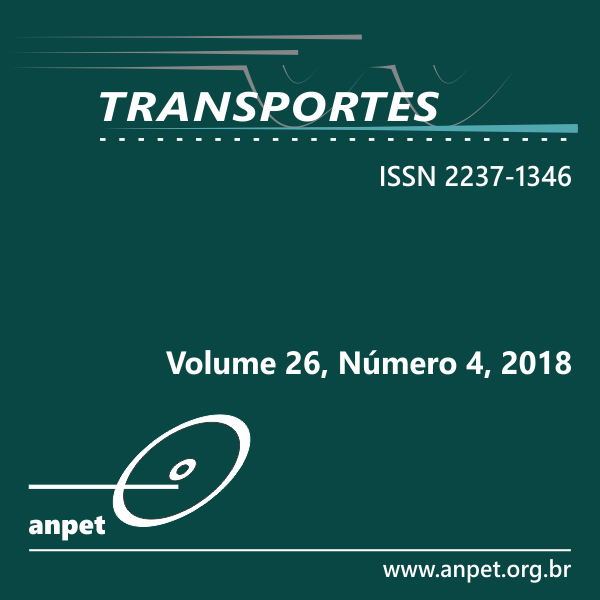Jatos ou Turboélices: Eficiência no consumo de combustível através de análise envoltória de dados
DOI:
https://doi.org/10.14295/transportes.v26i4.1494Keywords:
Turboélice, Jato, Combustível, Custo, Meio ambiente, Linha aérea.Abstract
Na indústria aeronáutica, o combustível é um dos mais caros insumos e, com o incessável desejo por redução de custos, as companhias aéreas buscam a otimização de suas frotas através da seleção do conjunto aeronave e motor mais eficiente para as rotas e frequências que operam. Dentro deste contexto, o presente artigo estuda o consumo de combustível de quatro companhias aéreas estadunidenses, sendo: (i) uma com frota composta exclusivamente por jatos regionais, (ii) outra por turboélices, (iii) uma terceira por jatos narrowbodies e (iv) uma quarta com frota mista de jatos regionais e turboélices. A contribuição deste trabalho reside na verificação da eficiência no consumo de combustível através de uma Análise Envoltória de Dados (DEA) tendo como premissas retorno de escala constante (CRS) e variável (VRS). Os resultados indicam que as frotas (ii) e (iii) são mais eficientes que as frotas (i) e (iv) quando se utiliza modelo DEA CRS. A abordagem VRS, no entanto, demonstra que as quatro empresas são igualmente eficientes no consumo de combustível. Ou seja, as frotas (i) e (iv) já apresentariam as melhores práticas, mas enfrentariam problema de escala. No entanto, não é possível afirmar categoricamente que os resultados se devem exclusivamente ao tipo de frota dado os diferentes mercados de atuação de cada empresa.
Downloads
References
ABEAR, Panorama da Aviação Brasileira, http://panorama.abear.com.br/dados-e-estatisticas/custos-das-empresas/. Con-sultado em 28 de dezembro.
BABIKIAN, R.; LUKACHKO, S. P.; WAITZ, I. A. The historical fuel efficiency characteristics of regional aircraft from technological, operational and cost perspectives. Journal of Air Transport Management, p. 389-400, 2002. DOI: 10.1016/S0969-6997(02)00020-0
BONACCORSI, A.; GIURI, P. When shakeout doesn’t occur: The evolution of the turboprop engine industry. Research Policy, v. 29, p. 847-870, 2000. DOI: 10.1016/S0048-7333(00)00109-8
BRUECKNER, J. K., and PAI, V.; "Technological innovation in the airline industry: the impact of regional jets." International Journal of Industrial Organization, v. 27, p. 110-120, 2009. DOI: 10.1016/j.ijindorg.2008.05.003
GIVONI, M.; RIETVELD, P. The environmental implications of airlines’ choice of aircraft size. Journal of Air Transport Manage-ment, 2010. DOI: 10.1016/j.jairtraman.2009.07.010
KARLAFTIS, M., TSAMBOULAS, D.; Efficiency measurement in public transport: are findings specification sensitive? Transpor-tation Research Part A, v, 46, p. 392–402, 2012. DOI: 10.1016/j.tra.2011.10.005
REINAS, R. I.; MARIANO, E. B.; REBELATTO, D. A. N.. Custo/benefício de aeronaves: uma abordagem pela Análise Envoltória de Dados. Produção, p. 684-695, 2011.
RYERSON, M. S.; GE, X. The role of turboprops in China’s growing aviation system. Journal of Transport Geography, p. article in press, 2014. DOI: 10.1016/j.jtrangeo.2014.03.009
RYERSON, M. S.; HANSEN, M. The potential of turboprops for reducing aviation fuel consumption. Transportation Research Part D, p. 305-314, 2010. DOI: 10.1016/j.trd.2010.03.003
RYERSON, M. S.; HANSEN, M. Capturing the impact of fuel price on jet aircraft operating costs with Leontief technology and econometric models. Transportation Research Part C, v. 33, p. 282-296, 2013. DOI: 10.1016/j.trc.2011.05.015
SHERMAN, H. D.; ZHU, J. Service Productivity Management, Improving Service Performance with DEA. 328p, 2006. DOI: 10.1007/0-387-33231-6
TOFALLIS, C.; Input efficiency profiling: an application to airlines. Computers. Ops Res, v. 24, p. 253–258, 1997. DOI: 10.1016/S0305-0548(96)00067-6
TONA, C.; RAVIOLO, P. A.; PELLEGRINI, L. F.; OLIVEIRA JÚNIOR, S. Exergy and thermoeconomic analysis of a turbofan engine during a typical commercial flight. Energy, 2010. DOI: 10.1016/j.energy.2009.06.052
ZOU, B.; ELKE, M.; HANSEN, M.; KAFLE, N. Evaluating air carrier fuel efficiency in the US airline industry. Transportation Rese-arch Part A, 59, 2014. 306-330. DOI: 10.1016/j.tra.2013.12.003
Downloads
Published
How to Cite
Issue
Section
License
Authors who submit papers for publication by TRANSPORTES agree to the following terms:
- The authors retain the copyright and grant Transportes the right of first publication of the manuscript, without any financial charge, and waive any other remuneration for its publication by ANPET.
- Upon publication by Transportes, the manuscript is automatically licensed under the Creative Commons License CC BY 4.0 license. This license permits the work to be shared with proper attribution to the authors and its original publication in this journal.
- Authors are authorized to enter into additional separate contracts for the non-exclusive distribution of the version of the manuscript published in this journal (e.g., publishing in an institutional repository or as a book chapter), with recognition of the initial publication in this journal, provided that such a contract does not imply an endorsement of the content of the manuscript or the new medium by ANPET.
- Authors are permitted and encouraged to publish and distribute their work online (e.g., in institutional repositories or on their personal websites) after the editorial process is complete. As Transportes provides open access to all published issues, authors are encouraged to use links to the DOI of their article in these cases.
- Authors guarantee that they have obtained the necessary authorization from their employers for the transfer of rights under this agreement, if these employers hold any copyright over the manuscript. Additionally, authors assume all responsibility for any copyright infringements by these employers, releasing ANPET and Transportes from any responsibility in this regard.
- Authors assume full responsibility for the content of the manuscript, including the necessary and appropriate authorizations for the disclosure of collected data and obtained results, releasing ANPET and Transportes from any responsibility in this regard.










